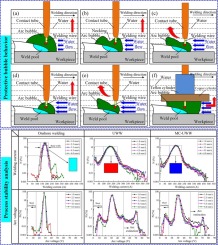当前位置:
X-MOL 学术
›
J. Mater. Process. Tech.
›
论文详情
Our official English website, www.x-mol.net, welcomes your feedback! (Note: you will need to create a separate account there.)
Effects of welding speed on bubble dynamics and process stability in mechanical constraint-assisted underwater wet welding of steel sheets
Journal of Materials Processing Technology ( IF 6.3 ) Pub Date : 2019-02-01 , DOI: 10.1016/j.jmatprotec.2018.09.022 Jianfeng Wang , Qingjie Sun , Zuchen Pan , Jie Yang , Jicai Feng
Journal of Materials Processing Technology ( IF 6.3 ) Pub Date : 2019-02-01 , DOI: 10.1016/j.jmatprotec.2018.09.022 Jianfeng Wang , Qingjie Sun , Zuchen Pan , Jie Yang , Jicai Feng

|
Abstract Dynamic behavior of the bubble was investigated by high-speed camera and using the dysprosium lamp method for welding speed ranging from 1.0 mm/s to 6.0 mm/s during conventional underwater wet welding and mechanical constraint-assisted underwater wet welding. Process stability analysis was conducted by welding electric signal to predict the evolution of bubble features. For conventional underwater wet welding, the variation in bubble geometry over time is visually observed and its track morphology changes from a vertically upward track to a deflected track with increasing welding speed. The stable and sustained bubble with its structural integrity benefits from mechanical constraint for all welding speeds. Mechanical constraint can compensate for the insufficient bubble protection and successfully prevent further bubble-induced perturbation on welding arc. In comparison to onshore welding and underwater wet welding with mechanical constraint, conventional underwater wet welding indicates the most variation of welding electric signal. The variation coefficient exhibits similar result with welding speed for the exertion of mechanical constraint, whereas the difference in variation coefficient exists for conventional underwater wet welding. The direct observation over weld morphology is also demonstrated to show the feasibility of bubble control using the developed process. Discernible difference in weld penetration appears, displaying higher value with mechanical constraint than without mechanical constraint.
中文翻译:

焊接速度对机械约束辅助钢板水下湿焊过程中气泡动力学和工艺稳定性的影响
摘要 通过高速摄像机和镝灯法,在常规水下湿焊和机械约束辅助水下湿焊中焊接速度范围为1.0 mm/s至6.0 mm/s,研究了气泡的动态行为。通过焊接电信号进行工艺稳定性分析来预测气泡特征的演变。对于传统的水下湿焊,可以直观地观察气泡几何形状随时间的变化,其轨迹形态随着焊接速度的增加而从垂直向上的轨迹变为偏转轨迹。稳定且持续的气泡及其结构完整性受益于所有焊接速度的机械约束。机械约束可以弥补气泡保护不足,并成功防止焊接电弧进一步由气泡引起的扰动。与有机械约束的陆上焊和水下湿焊相比,传统的水下湿焊表明焊接电信号的变化最大。在施加机械约束的情况下,变异系数与焊接速度表现出相似的结果,而传统水下湿焊的变异系数存在差异。对焊缝形态的直接观察也证明了使用开发的工艺控制气泡的可行性。出现明显的焊缝熔深差异,显示有机械约束的值高于无机械约束的值。与有机械约束的陆上焊和水下湿焊相比,传统的水下湿焊表明焊接电信号的变化最大。在施加机械约束的情况下,变异系数与焊接速度表现出相似的结果,而传统水下湿焊的变异系数存在差异。对焊缝形态的直接观察也证明了使用开发的工艺控制气泡的可行性。出现明显的焊缝熔深差异,显示有机械约束的值高于无机械约束的值。与有机械约束的陆上焊和水下湿焊相比,传统的水下湿焊表明焊接电信号的变化最大。在施加机械约束的情况下,变异系数与焊接速度表现出相似的结果,而传统水下湿焊的变异系数存在差异。对焊缝形态的直接观察也证明了使用开发的工艺控制气泡的可行性。出现明显的焊缝熔深差异,显示有机械约束的值高于无机械约束的值。在施加机械约束的情况下,变异系数与焊接速度表现出相似的结果,而传统水下湿焊的变异系数存在差异。对焊缝形态的直接观察也证明了使用开发的工艺控制气泡的可行性。出现明显的焊缝熔深差异,显示有机械约束的值高于无机械约束的值。在施加机械约束的情况下,变异系数与焊接速度表现出相似的结果,而传统水下湿焊的变异系数存在差异。对焊缝形态的直接观察也证明了使用开发的工艺控制气泡的可行性。出现明显的焊缝熔深差异,显示有机械约束的值高于无机械约束的值。
更新日期:2019-02-01
中文翻译:

焊接速度对机械约束辅助钢板水下湿焊过程中气泡动力学和工艺稳定性的影响
摘要 通过高速摄像机和镝灯法,在常规水下湿焊和机械约束辅助水下湿焊中焊接速度范围为1.0 mm/s至6.0 mm/s,研究了气泡的动态行为。通过焊接电信号进行工艺稳定性分析来预测气泡特征的演变。对于传统的水下湿焊,可以直观地观察气泡几何形状随时间的变化,其轨迹形态随着焊接速度的增加而从垂直向上的轨迹变为偏转轨迹。稳定且持续的气泡及其结构完整性受益于所有焊接速度的机械约束。机械约束可以弥补气泡保护不足,并成功防止焊接电弧进一步由气泡引起的扰动。与有机械约束的陆上焊和水下湿焊相比,传统的水下湿焊表明焊接电信号的变化最大。在施加机械约束的情况下,变异系数与焊接速度表现出相似的结果,而传统水下湿焊的变异系数存在差异。对焊缝形态的直接观察也证明了使用开发的工艺控制气泡的可行性。出现明显的焊缝熔深差异,显示有机械约束的值高于无机械约束的值。与有机械约束的陆上焊和水下湿焊相比,传统的水下湿焊表明焊接电信号的变化最大。在施加机械约束的情况下,变异系数与焊接速度表现出相似的结果,而传统水下湿焊的变异系数存在差异。对焊缝形态的直接观察也证明了使用开发的工艺控制气泡的可行性。出现明显的焊缝熔深差异,显示有机械约束的值高于无机械约束的值。与有机械约束的陆上焊和水下湿焊相比,传统的水下湿焊表明焊接电信号的变化最大。在施加机械约束的情况下,变异系数与焊接速度表现出相似的结果,而传统水下湿焊的变异系数存在差异。对焊缝形态的直接观察也证明了使用开发的工艺控制气泡的可行性。出现明显的焊缝熔深差异,显示有机械约束的值高于无机械约束的值。在施加机械约束的情况下,变异系数与焊接速度表现出相似的结果,而传统水下湿焊的变异系数存在差异。对焊缝形态的直接观察也证明了使用开发的工艺控制气泡的可行性。出现明显的焊缝熔深差异,显示有机械约束的值高于无机械约束的值。在施加机械约束的情况下,变异系数与焊接速度表现出相似的结果,而传统水下湿焊的变异系数存在差异。对焊缝形态的直接观察也证明了使用开发的工艺控制气泡的可行性。出现明显的焊缝熔深差异,显示有机械约束的值高于无机械约束的值。



























 京公网安备 11010802027423号
京公网安备 11010802027423号